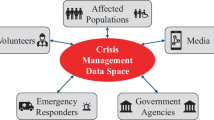Abstract
Increasingly powerful computational technology has caused enormous data growth both in size and complexity. A key issue is how to organize the data to adapt the challenges of data analysis. This paper borrows ideas from the Internet of things (IOT) into the digital world and organize the data entities to form a network, the Internet of data (IOD), which has huge potential in data-intensive applications. In the IOD, data hiding technology is utilized to embed virtual tags, which record all the activities of the data entities since they are created, into every data entity in the system. The IOD aims to organize the data to be interconnected as a network and collect useful information for data identification, data tracing, data vitalization and further data analysis.
Similar content being viewed by others
Explore related subjects
Discover the latest articles and news from researchers in related subjects, suggested using machine learning.References
Ashton K. That “Internet of things” thing. RFID Journal, 2009, 22: 97–114
SRI Consulting Business Intelligence. Appendix F: the Internet of things (background). http://www.dni.gov/nic/PDF_GIF_confreports/disruptivetech/appendix_F.pdf
Gershenfeld N, Krikorian R, Cohen D. The Internet of things. Scientific American, 2004, 291(4): 76–81
Brock D L. The electronic product code (EPC) — a naming scheme for physical objects. Massachusetts: MIT Auto-ID Center White Paper, 2001
Huvio E, Grönvall J, Främling K. Tracking and tracing parcels using a distributed computing approach. In: Proceedings of the 14th Annual Conference for Nordic Researchers in Logistics. 2002, 12–14
Wikipedia. Internet of things. http://en.wikipedia.org/wiki/Internet_of_Things
Want R. An introduction to RFID technology. IEEE Pervasive Computing, 2006, 5(1): 25–33
Hey A G T, Transley S, Tolle KM. The fourth paradigm: data-intensive scientific discovery. Microsoft Research, 2009
Collins J P. Sailing on an ocean of 0s and 1s. Science, 2010, 327(5972): 1455–1456
Nielsen M. A guide to the day of big data. Nature, 2009, 462(7274): 722–723
Markoff J. A deluge of data shapes a new era in computing. The New York Times, 2009
Chen Z, Fan W, Xiong Z, Zhang P, Luo L. Visual data security and management for smart cities. Frontiers of Computer Science in China, 2010, 4(3): 386–393
Xiong Z, Luo W, Chen L, Ni L M. Data vitalization: a new paradigm for large-scale dataset analysis. In: Proceedings of the 16th IEEE International Conference on Parallel and Distributed Systems. 2010, 251–258
Fan W, Chen Z, Chen M, Luo L, Xiong Z. Reversible data hiding with context modeling, generalized expansion and boundary map. Multimedia Tools and Applications (in Press)
Luo L, Chen Z, Chen M, Zeng X, Xiong Z. Reversible image watermarking using interpolation technique. IEEE Transactions on Information Forensics and Security, 2010, 5(1): 187–193
Chen M, Chen Z, Zeng X, Xiong Z. Reversible data hiding using additive predictionerror expansion. In: Proceedings of the 11th ACMWorkshop on Multimedia and Security. 2009, 19–24
Petitcolas F A P, Anderson R J, Kuhn M G. Information hiding-a survey. Proceedings of the IEEE, 1999, 87(7): 1062–1078
Moulin P, O’sullivan J A. Information-theoreticanalysis of information hiding. IEEE Transactions on Information Theory, 2003, 49(3): 563–593
Conner M. Sensors empower the “Internet of things”. EDN, 2010, 55(10): 32–38
Wikipedia. Internet. http://en.wikipedia.org/wiki/Internet
W3C. W3C semantic web frequently asked questions. http://www.w3.org/2001/sw/SW-FAQ
The SemanticWeb: An Introduction. http://infomesh.net/2001/swintro/
Tim B L, Hendler J, Lassila O. The semantic web. Scientific American Magazine, 2001
Wikipedia. Radio-frequency identification. http://en.wikipedia.org/wiki/Radio-frequency_identification
Cox I J, Kilian J, Leighton F T, Shamoon T. Secure spread spectrum watermarking for multimedia. IEEE Transactions on Image Processing, 1997, 6(12): 1673–1687
Cayre F, Fontaine C, Furon T. Watermarking security: theory and practice. IEEE Transactions on Signal Processing, 2005, 53(10): 3976–3987
Author information
Authors and Affiliations
Corresponding author
Additional information
Wei Fan received her BSc degree in computer science and technology from Beihang University, Beijing, China, in 2008. She is currently pursuing the PhD degree in computer application in the School of Computer Science and Engineering, Beihang University, Beijing, China. Her research interests include image forensics, digital watermarking, steganography, steganalysis, and image processing.
Zhengyong Chen received his BSc and PhD degrees in precision instruments and mechanology from Tsinghua University, Beijing, China, in 1998 and 2003, respectively. He was a Postdoctoral researcher in Department of Computer Science and Technology, Tsinghua University, from 2004 to 2005. Since 2006, he is an associate professor of the School of Computer Science and Engineering of Beihang University. His research interests include information hiding, digital watermarking, and digital rights management.
Zhang Xiong received his BS degree from Harbin Engineering University in 1982. He received his MS degree from Beihang University in 1985. He is a professor and PhD supervisor in the School of Computer Science and Engineering, Beihang University. He is working on computer vision, wireless sensor networks, information security, and data vitalization.
Hui Chen received his BSc and MSc in computer science and technology from Beihang University, Beijing, China, in 2006 and 2009, respectively. He is now working in Sino-French Engineering School in Beihang University. His research interests include digital watermarking, image processing.
Rights and permissions
About this article
Cite this article
Fan, W., Chen, Z., Xiong, Z. et al. The Internet of data: a new idea to extend the IOT in the digital world. Front. Comput. Sci. 6, 660–667 (2012). https://doi.org/10.1007/s11704-012-1036-z
Received:
Accepted:
Published:
Issue Date:
DOI: https://doi.org/10.1007/s11704-012-1036-z




